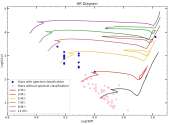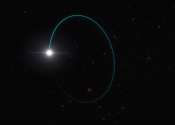Astronomers discover largest stellar black hole in Milky Way: Study
Astronomers identified the largest stellar black hole yet discovered in the Milky Way, with a mass 33 times that of the Sun, according to a study published on Tuesday.

Astronomers identified the largest stellar black hole yet discovered in the Milky Way, with a mass 33 times that of the Sun, according to a study published on Tuesday.
Astronomy
Apr 20, 2024
2
109

Using the Lowell Discovery Telescope (LDT), astronomers from the Lowell Observatory in Flagstaff, Arizona, have observed a young Galactic open cluster known as Berkeley 50. Results of the observational campaign, presented ...

Astronomers have identified the most massive stellar black hole yet discovered in the Milky Way galaxy. This black hole was spotted in data from the European Space Agency's Gaia mission because it imposes an odd 'wobbling' ...
Astronomy
Apr 16, 2024
1
869

Glittering threads of stars around the Milky Way may hold answers to one of our biggest questions about the universe: what is dark matter? With images taken through six different color filters mounted to the largest camera ...
Astronomy
Apr 15, 2024
1
38

Ancient Egyptians were known for their religious beliefs and astronomical knowledge of the sun, moon, and planets, but up until now, it has been unclear what role the Milky Way played in Egyptian religion and culture.
Archaeology
Apr 9, 2024
1
354

This image from the NASA/ESA Hubble Space Telescope features Arp 72, a very selective galaxy group that only includes two galaxies interacting due to gravity: NGC 5996 (the large spiral galaxy) and NGC 5994 (its smaller companion, ...
Astronomy
Apr 8, 2024
0
51

Astronomers from the University of Warsaw, Poland and elsewhere have detected a new classical Cepheid variable star. The newfound star, which received designation OGLE-GD-CEP-1884, has the longest pulsation period known among ...

Sometime between now and September, a massive explosion 3,000 light years from Earth will flare up in the night sky, giving amateur astronomers a once-in-a-lifetime chance to witness this space oddity.
Astronomy
Apr 6, 2024
2
1106

Guessing your age might be a popular carnival game, but for astronomers it's a real challenge to determine the ages of stars. Once a star like our sun has settled into steady nuclear fusion, or the mature phase of its life, ...
Astronomy
Apr 4, 2024
1
61

After two decades of work, scientists and engineers at the Department of Energy's SLAC National Accelerator Laboratory and their collaborators are celebrating the completion of the Legacy Survey of Space and Time (LSST) Camera.
Astronomy
Apr 3, 2024
0
56